|
|
|
Sort Order |
|
|
|
Items / Page
|
|
|
|
|
|
|
| Srl | Item |
| 1 |
ID:
095648
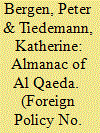

|
|
|
| 2 |
ID:
110149
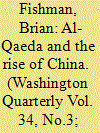

|
|
|
| 3 |
ID:
139661
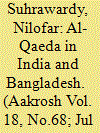

|
|
|
| 4 |
ID:
134419


|
|
|
|
|
| Publication |
Berkeley, University of California, 2013.
|
| Description |
xxvii, 324p.Hbk
|
| Contents |
B
|
| Standard Number |
9780520274204
|
|
|
|
|
|
|
|
|
|
|
|
Copies: C:1/I:0,R:0,Q:0
Circulation
| Accession# | Call# | Current Location | Status | Policy | Location |
| 057917 | 363.32509546/ROB 057917 | Main | On Shelf | General | |
|
|
|
|
| 5 |
ID:
093009
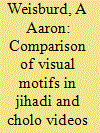

|
|
|
|
|
| Publication |
2009.
|
| Summary/Abstract |
Homegrown Sunni extremists (jihadis) and Latin American street gang members (cholos) represent potential threats to national security. Both groups are known to inhabit the video- sharing website YouTube. Videos representative of each group were selected at random, and the visual motifs in the videos were categorized. Findings suggest similarities and differences between the two groups that may have significance for how practitioners address each threat, and for determining the likelihood that the two groups may begin to work in concert. The portraits that emerge of jihadis and cholos may assist in developing strategies to counter the violence perpetrated by each.
|
|
|
|
|
|
|
|
|
|
|
|
|
|
|
|
| 6 |
ID:
083816
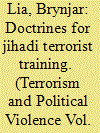

|
|
|
|
|
| Publication |
2008.
|
| Summary/Abstract |
Based on an in-depth review of jihadi discourse on terrorist training and preparation, this article finds considerable differences between leading jihadi theorists on issues such as how training should be defined, its ultimate purpose, and where and how to prepare jihadi fighters. However, they all agree on the importance of training, and that ideological indoctrination and spiritual preparation should take precedence over physical and military training. The preparatory process must produce battle-hardened, martyrdom-seeking fighters, whose primary strength lies in their spiritual determination, their patience, and a willingess to employ savagery against the enemy.
|
|
|
|
|
|
|
|
|
|
|
|
|
|
|
|
| 7 |
ID:
092440
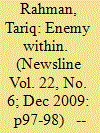

|
|
|
| 8 |
ID:
064473
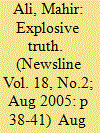

|
|
|
| 9 |
ID:
175739
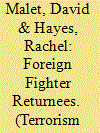

|
|
|
|
|
| Summary/Abstract |
How long does it typically take a returned foreign fighter to launch a domestic terror attack? The issue of returnees, and appropriate national and international responses to potential threats, has become a preeminent security concern of the 2010s, impacting policies on everything from refugees to whether to permit ISIS fighters to leave the theater of conflict alive. This article attempts to illuminate these contentious debates through a new data set of Lags in Attack Times of Extremist Returnees (LATER) that examines 230 jihadi returnees to Western countries. The data indicate that the majority of attempted attacks occur within one year, with a median lag time of just four months. Prison appears to play no role in lag times. Our findings indicate that security and reintegration efforts should be targeted within the critical six months after return, which diminishes the risk of attack considerably.
|
|
|
|
|
|
|
|
|
|
|
|
|
|
|
|
| 10 |
ID:
103425
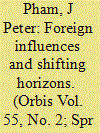

|
|
|
| 11 |
ID:
119293
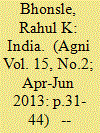

|
|
|
| 12 |
ID:
132289
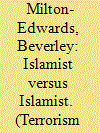

|
|
|
|
|
| Publication |
2014.
|
| Summary/Abstract |
Islam's diversity is a direct result of centuries of schism and factionalism, and presents a challenge to the original spirit of unity as envisaged by its founder, the Prophet Mohammed. Rivalry within Islam undermines the precedent notion of unity through communal belonging (tawhid and ummah). Yet in the twenty-first century this diversity is ignored, and political Islam is represented as being more of a monolith than a spectrum of ideas and aspirations. Generally, the materialization of new Islamist groups is a challenge to those who hold that unity is all. In the Gaza Strip, specifically, the dominant Islamist actor, Hamas, is facing internal challenges from other Islamist elements. These rival Islamists are also influenced by events across their border in post-revolutionary Egypt where a plethora of new Islamist actors are vying for political space and power. This article deals with Hamas's Islamist rivals, and the effects they have had on Hamas's governance of the Gaza Strip, and political and religious legitimacy within it. It will focus on ideological and violent disputes between the Islamist elements in Gaza, and the means by which Hamas and its security elements have tackled newly emerging rivals.
|
|
|
|
|
|
|
|
|
|
|
|
|
|
|
|
| 13 |
ID:
056232
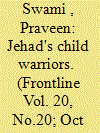

|
|
|
| 14 |
ID:
094762
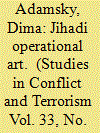

|
|
|
|
|
| Publication |
2010.
|
| Summary/Abstract |
Western scholars of jihadi strategic studies traditionally concentrate either on ideological-strategic or on tactical questions. This intellectual disposition overlooks operational art-an important layer of knowledge between strategy and tactics. Despite the absence of the term from classical jihadi literature, the discourse in the Salafi jihadi strategic studies community is replete with discussions related to it. Neither "small strategy" nor "grand tactics," operational art is a separate domain of knowledge. It serves as a framework for formulating principles of war, concrete fighting doctrines and integrates ends, methods, and means across all spheres of war-fighting. This article contributes to the Western scholarly understanding of Salafi strategic behavior by outlining a research program that will follow this overlooked development in jihadi military thought.
|
|
|
|
|
|
|
|
|
|
|
|
|
|
|
|
| 15 |
ID:
187467
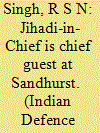

|
|
|
| 16 |
ID:
076944
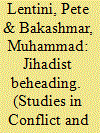

|
|
|
|
|
| Publication |
2007.
|
| Summary/Abstract |
Although contemporary jihadist terrorists are most well known for perpetrating operations that generate mass casualties, they also conduct violent acts that yield fewer victims, such as beheading hostages. Examining the religious and cultural contexts that surround jihadist beheadings, developments in new media, and drawing on examples from the Chechen Wars and the Iraq War, this article argues that jihadists have employed this tactic for a range of reasons, including obtaining ransom payments, hampering foreign investment, discrediting transitional states, and recruiting supporters. It also suggests that jihadists' beheading of their captives corresponds with aspects of cosmic war, particularly on how religious terrorists' desires to please a deity and secure a place of honor in the hereafter has devalued the lives of both captor and prisoner. Consequently, contemporary jihadist beheading is an outgrowth of the practice of terrorist hostage taking. As this article goes to press (February 2007) UK authorities disrupted a terrorist cell allegedly plotting to behead British Muslim soldiers who served in Afghanistan and Iraq, and to broadcast the filmed executions through jihadist websites. Journalists have described the intended beheadings and their dissemination as "Iraq-style." There is no doubt that jihadist beheading became more widely known as a result of the Iraq conflict. However, the beheadings in Iraq were largely used to recruit future jihadists and to demonstrate jihadists' strength to their potential support base, the global Muslim community. In contrast, the alleged UK beheading plot was aimed at striking terror into Muslims living in the UK so that they would not support or serve their government. Indeed the Iraq beheadings were intended to persuade, and the UK plot was intended to dissuade. These alleged activities suggest that contemporary jihadist beheading is not only an extension of hostage-taking, it is also an independently evolving terrorist tactic.
|
|
|
|
|
|
|
|
|
|
|
|
|
|
|
|
| 17 |
ID:
095228
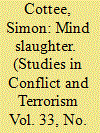

|
|
|
|
|
| Publication |
2010.
|
| Summary/Abstract |
This article focuses on the neutralizations of the jihadi Salafi ideology. It is divided into three parts. The first describes the various rhetorical accounts that ordinary people use to neutralize conventional moral controls against inhumane conduct. The second traces how these accounts inform and drive the jihadi Salafi worldview. The third, and concluding, part of the article sketches out the policy implications of the analysis set out here, arguing that any attempt to derail the global Salafi jihad must critically undermine the core neutralizations of the jihadi Salafi ideology, since it is these which enable jihadi combatants to escape conventional moral constraints and perpetrate acts of inhumanity.
|
|
|
|
|
|
|
|
|
|
|
|
|
|
|
|
| 18 |
ID:
103424


|
|
|
|
|
| Publication |
2011.
|
| Summary/Abstract |
This article provides a review of the history of jihadi foreign fighters in Afghanistan over the last 30 years. It details the post-9/11 period and the invasion of Afghanistan by U.S. forces, focusing on the ethnic origin of the foreign fighters and how different groups engaged in different aspects of the conflict. Additionally, the piece explains that while the foreign fighters who came to fight alongside the Taliban in Afghanistan included, among others, Uzbekistanis (not Afghan Uzbeks), Turks, and Arabs, there was also a significant force of Pakistanis-of both Pashtun and Punjabi origins-that joined, bolstering the Taliban army.
|
|
|
|
|
|
|
|
|
|
|
|
|
|
|
|
| 19 |
ID:
093159


|
|
|
| 20 |
ID:
066172
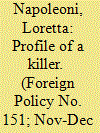

|
|
|
|
|
|
|
|